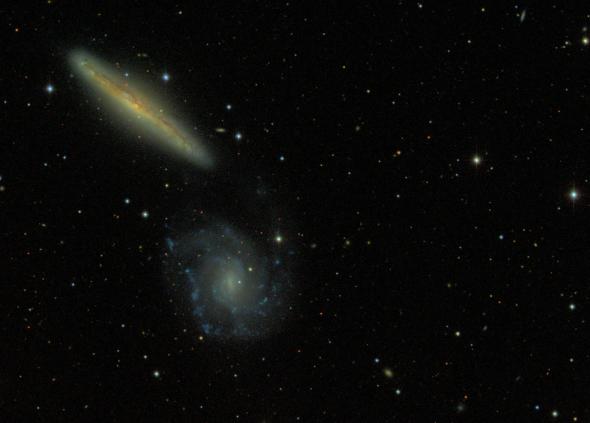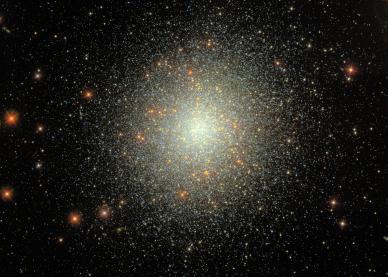
| SDSS Classic |
| SDSS.org |
| SDSS4.org |
| SDSS3.org |
| SDSS Data |
| DR17 |
| DR10 |
| DR7 |
| Science |
| Press Releases |
| Education |
| Image Gallery |
| Legacy Survey |
| SEGUE |
| Supernova Survey |
| Collaboration |
| Publications |
| Contact Us |
| Search |

Sloan Digital Sky Survey Releases Six Terabytes of Data to Public
CONTACTS:Michael Strauss, Scientific Spokesperson, Sloan Digital Sky Survey, (609) 258-3808, strauss@astro.princeton.edu
Alex Szalay, The Johns Hopkins University, (410) 516-7217 szalay@pha.jhu.edu
Gary S. Ruderman, Public Information Officer, The Sloan Digital Sky Survey, 312-320-4794 (cell), sdsspio@aol.com
March 15, 2004 - One of the largest astronomy catalogs ever compiled was released to the public today by the Sloan Digital Sky Survey (SDSS).
With photometric and spectroscopic observations of the sky gathered during the last two years, this second data release (DR2) offers six terabytes of images and catalogs, including two terabytes in an easy to use searchable database.
This public data release provides digital images and measured properties of more than 88 million celestial objects, as well as spectra and redshifts of over 350,000 objects. The data are available from the SDSS Web site (http://classic.sdss.org/DR2) or from the SkyServer Web site more attuned to the general public (http://skyserver.sdss.org/).
The SDSS is the most ambitious astronomical survey ever undertaken. A consortium of more than 200 astronomers at 13 institutions around the world, the SDSS will map in detail one-quarter of the entire sky, determining the positions and brightnesses of several hundred million celestial objects. It will also measure the distances to approximately one million galaxies and quasars.
"Getting DR2 out to the broader astronomical community and to the general public will allow these data to be analyzed for projects limited only by the imagination and ingenuity of the user," said Michael Strauss of Princeton University, scientific spokesperson for the SDSS.
Strauss explained that while members of the SDSS international collaboration have written more than 200 scientific papers with SDSS data, "we feel we've barely started. There is far more interesting science to be done and discoveries to be made with these data than we have time or people to do. This is why this data release is so important." Public searchable data in the survey have doubled from June 2003 to today.
"Many external researchers are already using the data from earlier public releases", explained Alex Szalay of the Johns Hopkins University, an architect of the SDSS's data mining tools. In fact, researchers from outside of the consortium wrote roughly half of the SDSS-related papers presented at recent American Astronomical Society meetings. "This is a clear indication that we've kept our promise to the scientific community of getting them uniformly high quality data in a timely manner and in a searchable format."
The first public data release from the SDSS in 2003 contained information on 50 million objects, including spectra and redshifts for almost 200,000 of these objects. The SDSS is an ongoing survey that recorded its first observations in May 1998 and is funded for operations through Summer 2005.
The 2.5-meter SDSS telescope is located at Apache Point Observatory in New Mexico and is operated by the Astrophysical Research Consortium. The telescope has two main instruments: an imaging camera, one of the largest ever built, and a spectrograph capable of recording data from 640 objects at a time. The camera creates images from digital scans through five filters: ultraviolet, green, red, and two infrared bands.
CATALOG OF RESULTS
Scientific findings and ground-breaking discoveries already achieved with the DR2 data from the most distant quasars, to the coolest stars, the properties of galaxies to the sizes of asteroids, the structure of the halo of our Milky Way and the large-scale structure of the universe.
DR2 consists of images from 3,324 square degrees of the Northern sky and more than 88 million galaxies, stars, and quasars. The survey is complete for objects as faint as 22.2 magnitude, three million times fainter than the faintest star that can be seen with the naked eye on a dark night.
In addition to images from the SDSS telescope, the DR2 includes the spectra, and therefore redshifts, of 260,000 galaxies, 36,000 quasars, and 48,000 stars, according to consortium member Mark Subbarao of the University of Chicago. The galaxy and quasar catalogs are the largest ever produced.
SEARCH REFINEMENTS
Jim Gray of Microsoft Corp. was part of the team working to make the observations accessible to the astronomical community and the public. The team developed several algorithms to efficiently search the complicated database.
"The SDSS is a BIG database with researchers making very complicated queries for spatial, color and space parameters," explained Gray, a distinguished engineer in Microsoft's Scaleable Servers Research Group and manager of Microsoft's Bay Area Research Center.
"It has been very rewarding working with the SDSS. The people are very creative, enthusiastic, and bright. The SDSS has shown that we database folks need to do a better job in many ways," Gray said. "For Microsoft, the SkyServer and Catalog Archive Server are an information-at-your-fingertips project we've helped develop for astronomers. I see them as archetypes of what all the sciences need."
Ani Thakar, an SDSS astronomer from the Johns Hopkins University's Center for Astrophysical Sciences, who has worked closely with Szalay and Gray on the SkyServer, said the DR2 database has a form-based Web page for imaging and spectroscopic queries.
"This gives astronomers the ability to extract detailed information from the database without having to learn a query language. We've also added a batch service that lets users submit queries that are likely to take a long time. They can come back later and pick up the results," Thakar explained.
DR2 also offers enhanced querying and filtering options like image cutout and finding chart services. Users can cross-identify objects by uploading lists of object positions on the sky.
The SDSS anticipates releasing more data in its ongoing celestial census late this year.

